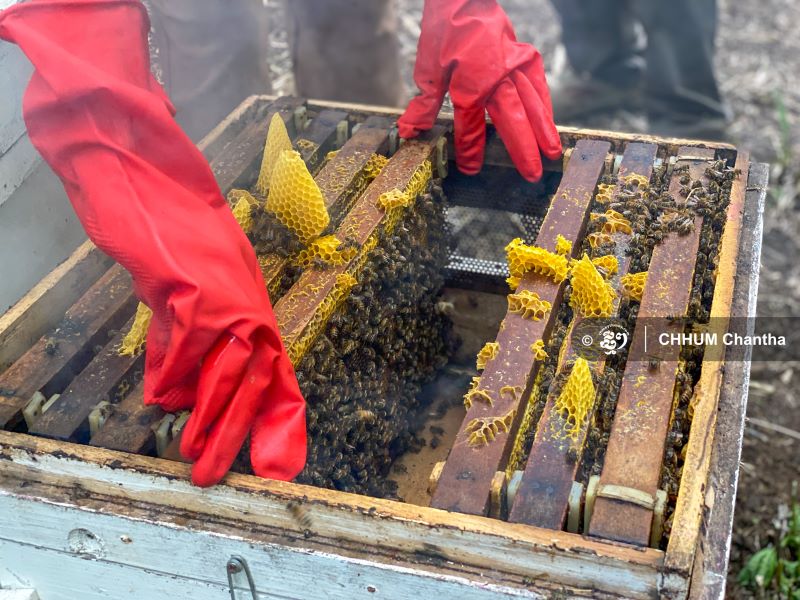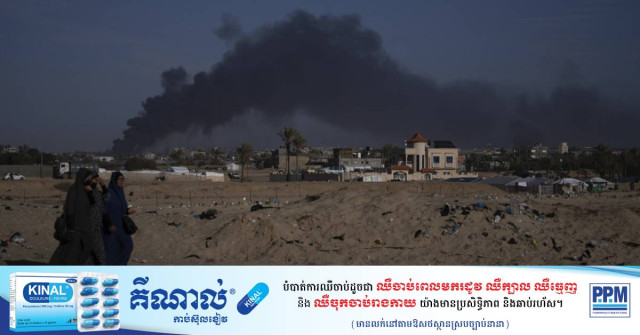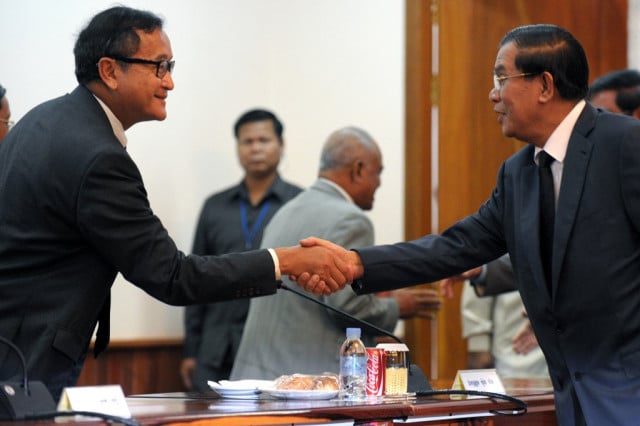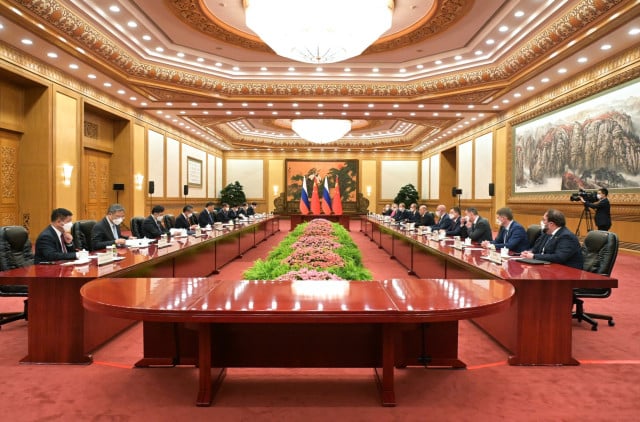An Angelina Jolie Foundation Bee-Raising Project Thrives in Battambang Province
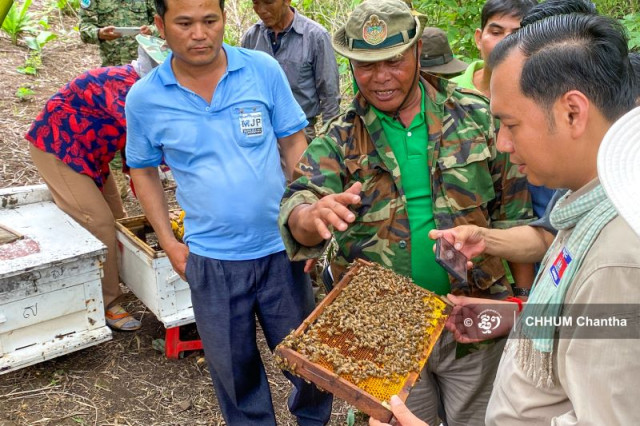
- By Torn Chanritheara
- July 2, 2023 11:20 AM
BATTAMBANG – Families in Battambang province are now earning additional income from raising bees in addition to what they get from growing their usual crops as part of efforts to stimulate the local economy, and this, with support from the foundation led by Hollywood star Angelina Jolie.
Jolie, through the Maddox Jolie-Pitts Foundation (MJP), has been implementing in Samlot district four main projects for which, in the case of the bee project, the foundation provides technical support and helps find markets.
Samlot District is home to the Samlot Multiple Use Area, which is a vast protected land in the southwestern part of Cambodia. Known for its rich natural resources and fertilized soil, the area is excellent for growing various crops such as mango, durian and Pailin longan.
With support from the MJP Foundation, local farmers have taken advantage of the numerous pollens produced by their flowers to feed their hungry bees.
As many as 14 of 18 communities in the Samlot District area are now benefiting from the project.
Duk Meng, head of one of the communities, said that raising bees has become the second job of most of the households in his community, providing additional money for families that are planting cassava, corn or durian as their main source of income.
Moel Sameth, who heads the MJP agriculture and bee-raising program, said that the foundation has provided technical support to families in the communities with the aim of having them make full use of the crops as much as possible. “We have seen that many farmers grow crops here like corn.
“Before they only collected corn,” he said. “But now, they can let the bees take the pollen from the corn flowers to produce honey before harvesting the corn.”
Three types of bees are being raised, Sameth explained. One is a local specie and the two others are imported from Europe, he said.
Through the Maddox Jolie-Pitts Foundation, farmers of the protected Samlot Multiple Use Area in Battambang Province have received training and technical support on keeping bees and harvesting honey. Photo: Chhum Chantha
The honey-bee business
Chey Rorng, who is one of the bee farmers, said that she can harvest honey faster that it takes her to plant crops. While she started with the one beehive the project gives each participant, Rorng has now expanded to 25 hives due to the skills she has acquired through the MJP project as far back as 2019, she said.
Because of that training, Rorng can identify the queen bee, knows how to take care of the bees, the type of flowers that can produce pollen and which are the enemies of the bees.
“We can harvest honey every half of each month if the flowers are good for the bees,” Rorng said. In a good harvest season, 10 hives can produce up to 50 liters, she said, adding that she can get 70,000 riel per liter ($17.50) on the retail market.
Rorng said the best time for collecting high-quality honey is between November and February since there is no rain. Honey can also be harvested from June to October but the quality is rather low compared to during the dry season, she said.
The money from bee keeping provides her a decent secondary income apart from growing crops. “My family’s welfare has improved since I started keeping bees,” she said. “Money from beekeeping has been used to buy necessities and school fees.”
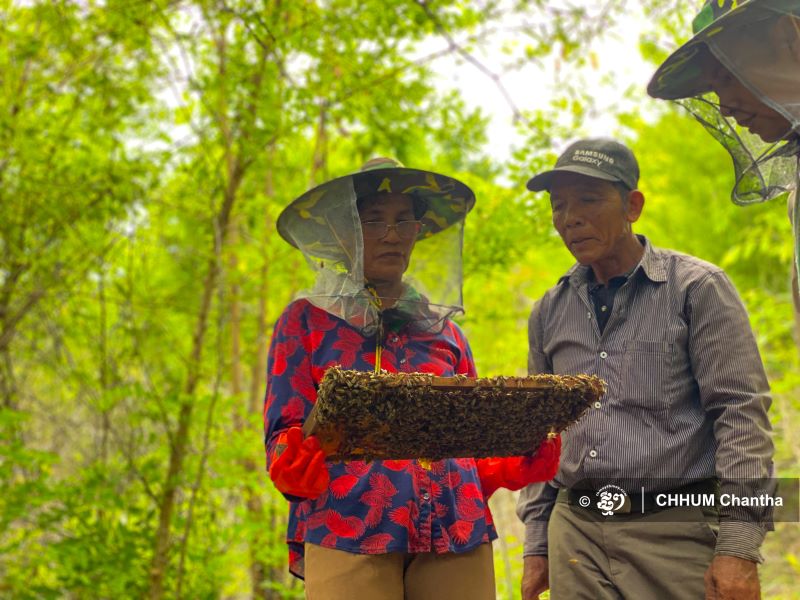
Protecting bee species for sustainable use
Neth Pheaktra, secretary of state at the Ministry of the Environment, said that protecting bee species is crucial for long-term honey harvesting and benefits.
During a recent visit to the Samlot protected area, Pheaktra said that the ministry had been working with UNESCO and other partners to prepare a roadmap for a national sustainable bee-raising and wild-bee conservation plan in the country. The many bee species roaming in the protected area have provided many benefits to the people, he said.
“For Cambodians, honey is only a medicine to cure diseases but also a kind of food that provide nutrients,” Pheaktra said.
There are two main sources to produce honey: wild bees and raised bees, he said. As the demand rises, harvesting honey from wild bees is not enough, and so beekeeping by local people can fill the shoes, he said.
Raising bee, Pheaktra said, is also part of the plans to protect bee species while at the same time providing people another source of income.
Noting that some people have used wrong methods to harvest honey such as using smoke from chemical substances or collecting honey by burning hives and killing queen bees in the process, and have even eaten young bees as food, Pheaktra said that it is important for people to learn to consider bees as a natural resource that is sustainable and should be protected.
Pheaktra said that raising bees does not only help boost ecological interdependence but also improve people’s livelihood by becoming a second source of income in addition to growing crops.






